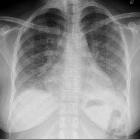CMV pneumonitis



Cytomegalovirus (CMV) pneumonia is a type of viral pneumonitis and occurs due to infection with cytomegalovirus (CMV), which is a member of the Herpetoviridae family.
Epidemiology
CMV infection is particularly important in those who are immunocompromised (e.g. those with AIDS / allogenic bone marrow transplantation ). In recipients of hematopoietic cell transplantations, the incidence of CMV can be around 20-35% .
Pathology
A major biological characteristic of CMV (as with other herpes viruses) is its ability to become latent in the human host and therefore the potential for reactivation.
Radiographic features
Plain radiograph
Findings on chest radiographs are usually non-specific.
CT
CT findings are non-specific and diverse and have been described without distinction between AIDS and non-AIDS patients. Commonly described findings include:
- mixed alveolar-interstitial infiltrative opacification
- ground-glass opacities
- relatively common feature, may be seen in ~67% of cases
- ground-glass opacities
- small pulmonary nodules
- nodules tend to have bilateral symmetrical distribution and involve all zones
- confluent consolidation
- may be more marked towards the lower lobes
- bronchiectasis
- interstitial reticulation without air space opacification
Other described features include:
- pulmonary masses
- tree in bud changes
- thickening of bronchovascular bundles
Differential diagnosis
The imaging differential is broad but in the immunosuppressed population consider:
- pneumocystis jirovecii pneumonia
- may contain (not always) small intrapulmonary cysts on CT
- may have a more apical distribution
- the ground glass changes may be more homogeneous
- other forms of viral pneumonitis
Siehe auch:
und weiter:

 Assoziationen und Differentialdiagnosen zu Cytomegalovirus pneumonia:
Assoziationen und Differentialdiagnosen zu Cytomegalovirus pneumonia:
